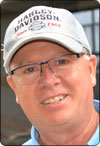
Working at a south Minneapolis auto shop, Jay Capistrant often visited with operators who came in to escape the cold during their breaks. The conversations sparked an interest in the job and, in 1974, led him to apply. He began his career at the old Northside Garage and later spent time at the Nicollet and old Snelling garages. As an extraboard operator, he drove a variety of routes. Capistrant enjoyed the job and was a skilled operator, with impressive showings in two Bus Rodeos. But after six years behind the wheel, he found himself seeking better hours and less stress. He applied for and got a new job as a revenue clerk, a move that would lead to a nearly four-decade career in Revenue Operations. “I loved driving the bus, but I’ll always be grateful I made that switch,” Capistrant said.
Capistrant spent three years as a revenue clerk and spent another three years as a balancing clerk. At the time, operators manually recorded boardings on records known as trip sheets, which were then reviewed by clerks like Capistrant. Any irregularities discovered by clerks led to additional follow up. In 1986, Capistrant took on another new role, as a passenger sampling clerk, that would come to define his career. The job involved riding the bus or setting up somewhere along a route to count passengers, helping to develop ridership estimates. “I got to be out and about a lot, which was great except when it was 20 below,” Capistrant said.
The role took on greater visibility when the METRO Blue Line opened in 2004. Eager to know how many people were riding the state’s first light rail line, Capistrant spent hours riding the train to provide some of the first estimates. “Everyone was starving for ridership numbers so the train really became home to me there for a while,” he said. “That’s when I started noticing I’d need a seat cushion.” The appetite for information eventually began to wane, and technology was introduced that automatically counted passengers. Capistrant continued to ride, though, verifying data and making observations that helped estimate ridership for large events. Most days, he spent as much as five hours riding the Blue Line, Green Line or a bus. While focused on the task at hand, the job allowed him to befriend regular customers and fellow employees and to observe the daily life that unfolded on the train.
Near retirement, Capistrant said he was proud to have built a career at Metro Transit and amazed at the growth he’d witnessed during his 43 years of service. “When I started in 1974, this was just a bus company with a few old buses,” he said. “Now we have two light rail lines, millions of rides, we’ve helped the cities grow. I’m really proud to have been a part of that.” Capistrant’s career choice was also a fateful one: In 2002, he was introduced to a new co-worker, Mary Capistrant. He offered to help her with a carpentry project and she offered to make him dinner. Five years later, they were married.
In retirement, Capistrant planned to spend more time on a long-running family carpentry business, continue volunteering with Allina Health Hospice and restore a 1973 half-ton Chevy pick-up.